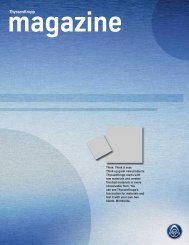Engineering
Engineering
Engineering
Create successful ePaper yourself
Turn your PDF publications into a flip-book with our unique Google optimized e-Paper software.
3.6 Consolidated financial statements Notes to the consolidated financial statements<br />
3.6 Consolidated financial statements Notes to the consolidated financial statements<br />
maturity. Financial transactions and the transactions undertaken by our<br />
subsidiaries outside the Euro zone are hedged in close cooperation<br />
with central Group management. Compliance with the Group’s<br />
requirements is regularly ascertained by our Corporate Center Internal<br />
Auditing.<br />
Foreign currency hedging is used to fix prices on the basis of hedging<br />
rates as protection against any unfavorable exchange rate fluctuations<br />
in the future. When hedging anticipated production-related ore, coal<br />
and coke purchases, favorable developments in the Euro/US dollar<br />
exchange rate are also systematically exploited.<br />
Hedging periods are generally based on the maturities of underlying<br />
transactions. Foreign currency derivative contracts usually have<br />
maturities of twelve months or less, but can also be significantly longer<br />
in exceptional cases. The hedging periods for forecasted ore, coal and<br />
coke purchases have been established on the basis of a theoretical fair<br />
exchange rate (based on purchasing power parity) and the margin of<br />
fluctuation between the US dollar and the Euro based on historical<br />
data. In accordance with a set pattern, purchases forecasted for a<br />
specific period are hedged whenever defined hedging rates are<br />
reached.<br />
The US dollar is the only relevant risk variable for sensitivity analyses<br />
under IFRS 7, as the vast majority of foreign currency cash flows<br />
occurs in US dollars. As hedging transactions are generally used to<br />
hedge underlying transactions, opposite effects in underlying and<br />
hedging transactions are almost entirely offset over the total period.<br />
Thus, the currency risk exposure described here results from hedging<br />
relationships with off-balance sheet underlying transactions, i.e.<br />
hedges of firm commitments and forecasted sales. Based on our<br />
analysis, the US dollar exposure as of September 30, 2011 was as<br />
follows:<br />
If the Euro had been 10% stronger against the US dollar as of<br />
September 30, 2011, the hedge reserve in equity and fair value of<br />
hedging transactions would have been €170 million (2010: €118<br />
million) lower and earnings resulting from the measurement as of the<br />
balance sheet date €88 million (2009/2010: €125 million) higher. If the<br />
Euro had been 10% weaker against the US dollar as of September 30,<br />
2011, the hedge reserve in equity and fair value of hedging<br />
transactions would have been €206 million (2010: €145 million) higher<br />
and earnings resulting from the measurement as of the balance sheet<br />
date €106 million (2009/2010: €151 million) lower.<br />
Interest rate risk<br />
Due to the international focus of ThyssenKrupp’s business activities,<br />
the Group procures liquidity to cover its financial needs in international<br />
money and capital markets in different currencies and with various<br />
maturities. Some of the resulting financial debt and financial<br />
investments are exposed to interest rate risk. The Group’s central<br />
interest rate management manages and optimizes interest rate risk.<br />
This includes regular interest analyses. In some cases, the Group uses<br />
derivatives to hedge interest rate risk. These instruments are<br />
contracted with the objective of minimizing interest rate volatilities and<br />
finance costs for underlying transactions.<br />
The major part of the interest derivatives is immediately and directly<br />
allocated to particular financings as cash flow or fair value hedges.<br />
These are derivatives that qualify for hedge accounting. A small part of<br />
the interest derivatives is not specifically allocated to an individual<br />
financing but hedges a portfolio of individual loans using a macro<br />
hedge approach.<br />
Cross currency swaps have been contracted primarily in connection<br />
with the US dollar financing activities.<br />
Interest rate instruments can result in cash flow risks, opportunity<br />
effects, as well as interest rate risks affecting the balance sheet and<br />
earnings. Refinancing and variable-rate financial instruments are<br />
subject to cash flow risk which expresses the uncertainty of future<br />
interest payments. Cash flow risk is measured by means of cash flow<br />
sensitivity. Opportunity effects arise from non-derivatives, as these are<br />
measured at amortized cost rather than fair value, in contrast to<br />
interest derivatives. This difference, the so-called opportunity effect,<br />
affects neither the balance sheet nor the statement of income. Onbalance<br />
sheet interest rate risks affecting equity result from the<br />
measurement of interest derivatives qualifying as cash flow hedges.<br />
Interest rate risks affecting earnings arise from the remaining interest<br />
rate derivatives not qualifying for hedge accounting. Opportunity<br />
effects and interest rate risks affecting the balance sheet and earnings<br />
are determined by calculating fair value sensitivity analyses and<br />
changes.<br />
As of September 30, 2011, a +100/(20) basis point parallel shift in<br />
yield curves is assumed for all currencies in interest analyses. In fiscal<br />
year 2008/2009 the parallel downward shift was reduced to (20) basis<br />
points to consider the reduced interest level as a result of the financial<br />
crisis and to avoid negative interest rates. Due to the still relatively low<br />
184

















